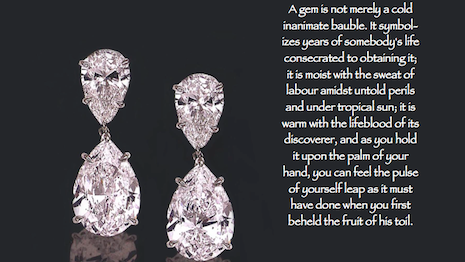
Many facets of diamonds
Most diamonds are sold through retail stores at very high profit margins. It is difficult for consumers and investors to buy wholesale prices. Polished diamonds at wholesale prices are 30 percent to 50 percent lower than retail.
Many people assume that diamonds are rare and precious. Men always want to know what a diamond is worth when buying an engagement ring. It is arguably worth nothing, but logic invented primarily by marketers to assign a value to it.
To its credit, De Beers started the marketing that diamonds are a symbol of love and commitment as well as “A Diamond is Forever” and “Diamonds are a Girl’s Best Friend,” which gave the opportunity for De Beers to master demand for consumers to buy diamonds.
De Beers also created the frame of how much a man should pay for a diamond engagement ring: a two-month salary.
De Beers continued to convince older women that they needed an eternity ring, giving them an opportunity to market melee diamonds that De Beers mined.
Dirt on the subject
Diamonds are essentially polished dirt. There is not a single accurate price guide for diamonds. Only a general index list price instead of actual transaction prices which is put out by Rapnet.com .
Other price guides such as PolishedPrices.com are based on selling prices of select wholesalers. There is no transparency, just convoluted formulas for diamond dealers to trick and deceive consumers to buy diamonds at retail prices while claiming to be selling at wholesale.
Without a standardized pricing model, there is a huge amount of room for diamond dealers to take advantage of consumers.
We still have brands that are sight holders of the De Beers conglomerate that launch well-orchestrated advertising and public relations campaigns to romanticize diamonds. This is where these brands give diamonds to celebrities for the red carpet, leaking photos to society magazines to convince customers to buy diamonds.
We even have jewelers who try to convince people that diamonds are an investment.
Yet according to PolishedPrices.com’s Diamond Composite Index, diamonds are up only 40 percent to 50 percent, while gold and silver goes up 400 percent to 600 percent over the same period.
According to Luis Basenese, former chief investor strategist for Wall Street Daily, “The lack of liquidity, poor demand and weak long-term make diamonds a terrible alternative to investing in gold and performance silver.”
Artificially inflating the actual cost of materials is what we see many people in the jewelry industry doing.
We see this practice where jewelry designers end up becoming brands and selling products in the marketplace that cost basically nothing to make.
We can also see this in the art market where the artist’s work is short lived. At least 98 percent of all contemporary art sold will never again be salable for the price paid originally.
This is also true for jewelry as well, where at least 99 percent of jewelry purchased by the buyer will not get the price paid for originally.
We only see this exception with designers such as JAR.
Usually the jewelry is worth, at best, 50 percent of its original cost, given that the cost included the jeweler’s markup of at least 100 percent.
Nub of the conflict
Jewelry designers are claiming to be selling “conflict-free diamonds,” “sustainable gold” and “ethically and eco-friendly jewelry.”
However, they are making their jewelry in Third World countries where most people make a dollar a day to produce jewelry that sells for thousands of dollars.
Many jewelers hide behind smoke and mirrors. Unfortunately, many diamond dealers and retail jewelry stores will try to exploit consumers.
There is tremendous amount false advertising to lure customers into their stores. There are also purchase add-on services such as “guarantee for life” or “free repairs.”
Using advertising and high-pressure sales tactics seems to be the way to go.
De Beers’ dominance in the diamond industry is a result of controlling supply and creating and sustaining demand, thanks to brilliant advertising delivering a consistent theme for a half-century.
The problem with diamonds is that they are plentiful and a mundane commodity. Online retailer Blue Nile has commoditized the diamond market, making it available to anyone, anywhere by a click of a button.
Diamond mines know that it is a commodity with no inherent value, but they try to make diamonds ritualistic and metaphoric while making the purchasing of a diamond mandatory without practical purpose.
There is a saying, “Find a need and fill it.” This is what Rio Tinto Argyle Pink Diamond Tender does when it markets the most rare diamonds in the world, pink and red diamonds, and brings only a select number into the market, inviting dealers to bid on these stones for millions of dollars.
A MINERAL THAT is composed entirely of carbon and is less stable than graphite and is one of the hardest materials known to mankind has caught the attention of our society, with marketing significantly affecting the image of diamonds as a valuable commodity.

Raymond Hakimi is analyst at Jewel of Ocean
Raymond Hakimi is analyst at Jewel of Ocean, New York. Reach him at raymond@jewelofocean.com.
The opinions expressed in this piece are solely the author’s.
from Jewelry – Luxury Daily https://www.luxurydaily.com/the-truth-about-diamonds/
via Your #1 Source to Finding Luxury & Designer Goods, Handbags & Clothes at or Below Wholesale: Click Here.
No comments:
Post a Comment